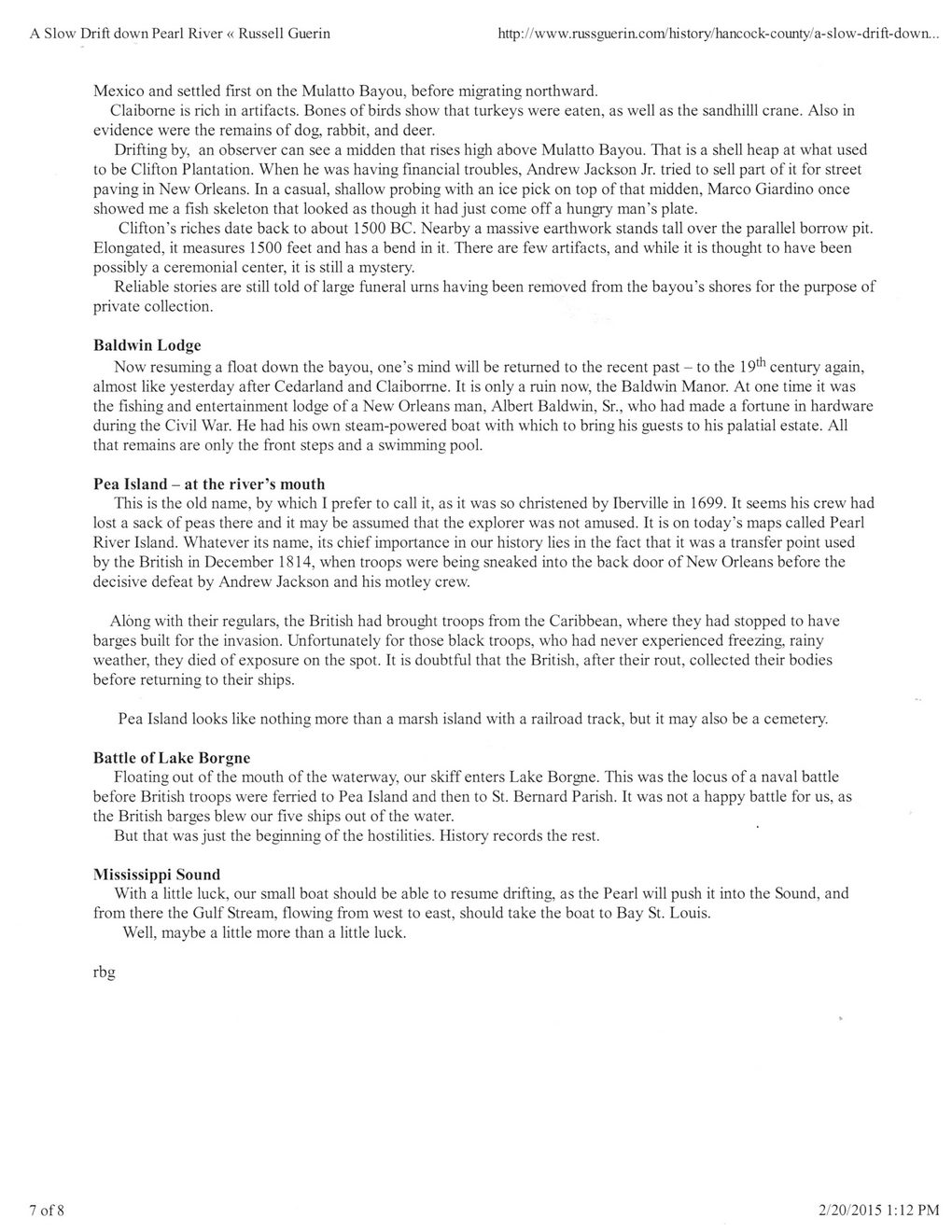This text was obtained via automated optical character recognition.
It has not been edited and may therefore contain several errors.
A Slow Drift down Pearl River « Russell Guerin http://www.russguerin.com/history/hancock-county/a-slow-drift-down. Mexico and settled first on the Mulatto Bayou, before migrating northward. Claiborne is rich in artifacts. Bones of birds show that turkeys were eaten, as well as the sandhilll crane. Also in evidence were the remains of dog, rabbit, and deer. Drifting by, an observer can see a midden that rises high above Mulatto Bayou. That is a shell heap at what used to be Clifton Plantation. When he was having financial troubles, Andrew Jackson Jr. tried to sell part of it for street paving in New Orleans. In a casual, shallow probing with an ice pick on top of that midden, Marco Giardino once showed me a fish skeleton that looked as though it had just come off a hungry man’s plate. Clifton’s riches date back to about 1500 BC. Nearby a massive earthwork stands tall over the parallel borrow pit. Elongated, it measures 1500 feet and has a bend in it. There are few artifacts, and while it is thought to have been possibly a ceremonial center, it is still a mystery. Reliable stories are still told of large funeral urns having been removed from the bayou’s shores for the purpose of private collection. Baldwin Lodge Now resuming a float down the bayou, one’s mind will be returned to the recent past - to the 19th century again, almost like yesterday after Cedarland and Claiborme. It is only a ruin now, the Baldwin Manor. At one time it was the fishing and entertainment lodge of a New Orleans man, Albert Baldwin, Sr., who had made a fortune in hardware during the Civil War. He had his own steam-powered boat with which to bring his guests to his palatial estate. All that remains are only the front steps and a swimming pool. Pea Island - at the river’s mouth This is the old name, by which I prefer to call it, as it was so christened by Iberville in 1699. It seems his crew had lost a sack of peas there and it may be assumed that the explorer was not amused. It is on today’s maps called Pearl River Island. Whatever its name, its chief importance in our history lies in the fact that it was a transfer point used by the British in December 1814, when troops were being sneaked into the back door of New Orleans before the decisive defeat by Andrew Jackson and his motley crew. Along with their regulars, the British had brought troops from the Caribbean, where they had stopped to have barges built for the invasion. Unfortunately for those black troops, who had never experienced freezing, rainy weather, they died of exposure on the spot. It is doubtful that the British, after their rout, collected their bodies before returning to their ships. Pea Island looks like nothing more than a marsh island with a railroad track, but it may also be a cemetery. Battle of Lake Borgne Floating out of the mouth of the waterway, our skiff enters Lake Borgne. This was the locus of a naval battle before British troops were ferried to Pea Island and then to St. Bernard Parish. It was not a happy battle for us, as the British barges blew our five ships out of the water. But that was just the beginning of the hostilities. History records the rest. Mississippi Sound With a little luck, our small boat should be able to resume drifting, as the Pearl will push it into the Sound, and from there the Gulf Stream, flowing from west to east, should take the boat to Bay St. Louis. Well, maybe a little more than a little luck. rbg 7 of 8 2/20/2015 1:12 PM

Pearl River Document (007)